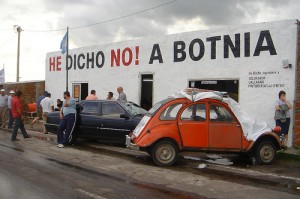Uruguayan president-elect José “Pepe” Mujica is trying to intervene in a conflict that started more than seven years ago, and which still makes headlines in Uruguayan and Argentinean Media. Since the opening of Finnish pulp mill Botnia in Fray Bentos (Uruguay) along the Uruguay River—a natural border between Argentina and Uruguay—environmentalists and locals from the area and its neighboring Argentinean city Gualeguaychú have been protesting against alleged environmental and health hazards caused by the mill.
Blogger and industrial designer Julián Ballesteros Riveros [es] spent recent Carnival celebrations in Gualeguaychú where he witnessed firsthand the activism against Botnia:
Una bella ciudad con gente muy amable, vale la pena conocerla si se tiene la oportunidad; tiene termales, zonas para acampar y playas a lo largo de la costanera del río Gualeguaychú. Sin embargo, aunque lo más atractivo resulta ser los recursos naturales de la zona, es llamativa la constante exposición de avisos en las casas, en los establecimientos comerciales y hasta en los automóviles oponiéndose al unísono a la amenaza contra el medio ambiente que supone la instalación de “papeleras” y de Botnia en particular en límites con Uruguay
Skepticism about the plant posing an actual environmental or health hazard opposes the claims made by environmentalists, as various organizations have denied that the mill contaminates the air. According to local news organization from Entre Rios, Agencia de Noticias de Entre Rios APFD [es] , Marisa Arienza from Green Cross reported that the there have not been any changes in the levels of sulfur dioxide in the air since the plant began operations.
Still, the strongest and most established protest came from the “piqueteros” who are discontent with the pulp mill and have used protest tactics like the takeover and blockade of bridges that act as important passage ways between the two countries for tourism and commercial purposes.

‘I Said No!’ Blockade from Fray Bentos, Uruguay and anti-Botnia slogans. Picture taken by Flickr user sebaperez and used under a Creative Commons license.
Mujica, who will not be sworn into office until March, has paid special attention to this conflict and wants the blockades lifted before he takes office. Mujica met with Cristina Kirchner, president of Argentina, and with the governor of the Argentinean region Entre Rios, Sergio Urribarri, where Gualeguaychú is located. However, environmentalist Lilian Melnik sees no progress in these meetings, as reported by local Uruguay River newspaper Rio Uruguay Digital [es]:
[Mujica y Urribarri] son ‘traidores a una causa noble’ hacia quienes ‘defienden el levantamiento del corte sin argumentos y sin querer verdaderamente que se vaya Botnia’
Melnik also said that environmentalist will have to defend the blockade even harder, now that Mujica has tried to mediate.
In an editorial, Ignacio de Posadas [es] criticizes these attempts made by the president-elect to reach out to the Argentinean side:
El Presidente electo, por sus gestos (sobre todo la visita a los piqueteros) y por sus palabras (describiendo la violación de tratados y de normas y usos, como “un asunto interno” de la Argentina), dio razón al gobierno Kirchner y a los patoteros de Gualeguaychú, banalizando el asunto, debilitando la posición jurídica y de principios del Uruguay y enviando a La Haya el peor mensaje posible (¿qué juez se parará en los pedales si la parte agraviada dice que todo es negociable?).
Shortly after taking office, Mujica will have to face the verdict from the International Court of Justice at The Hague, where Argentina issued a formal case against Uruguay in 2006. Mujica’s close relationship with Kirchner and his recent attempt to reach out to governor Urrubarru will also be tested when he becomes the official president.
Argentinean journalist and blogger Pepe Eliaschev [es] condemns the blockades as useless and contrasts Mujica’s close connection to the Kirchners with the current Uruguayan president Vázquez’ tumultuous relationship with the neighboring government:
En pocas palabras, el corte de la frontera con Uruguay no sirve para nada y es un pastiche siniestro que solo ha provocado daño. La planta de Botnia, inaugurada hace ya dos años, trabaja y produce con absoluta y total normalidad, y lo hace en toda su capacidad. El corte no solo no redujo el flujo de turistas, sino que lo incremento, demostrando la pasmosa estupidez de la medida. De la famosa “contaminación” nada significativo ha vuelto a aportarse, mientras que en el inicio del conflicto la llamada asamblea “ambientalista” de Gualeguaychú llegó a decir que la fabrica instalada en Uruguay era equivalente al Auschwitz, el campo de exterminio que los nazis instalaron en esa ciudad polaca durante la Segunda Guerra y donde fueron aniquilados centenares de miles de judíos. […] Operativo seducción: el viejo guerrillero quiere engullirse a la pareja presidencial argentina para que levanten el corte de la frontera. El septuagenario tupamaro imagina que podrá extraer de los post montoneros argentinos lo que le severidad del oncólogo socialista Vázquez no pudo.
Mujica has said he will not negotiate with “piqueteros,” and the “piqueteros” in turn, say they will not take action until the Hague pronounces its verdict.








5 comments
I’m a German, living in Uruguay since a couple of years. All this is a big shame – a shame for the politicians of Argentina, particularly for the Kirchners, a shame for the mercosur, which shows one time more that Uruguay, although a member of this union, isn’t worth – to small, to uninteresting, a shame, not at least, also for the helpless uruguayan politicians. But first of all – a shame to the argentine “piqueteros”. They are obviously not ashamed to block one of the most important economical veins of Uruguay for years, but what really really show me the deep stupidity of them is, that they are not ashamed to compare a paper-mill with the horror of Ausschwitz – for me as a German, that’s really a malice! Shame on you!